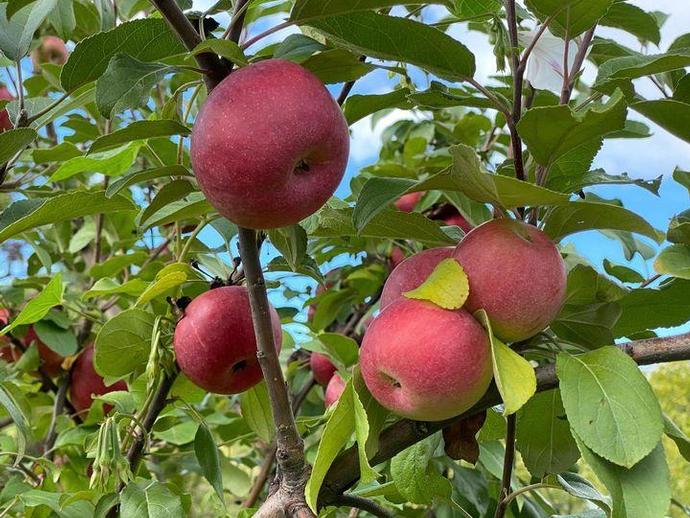October 12, 2021
Ben here with the Tuesday edition of #BenInNature presented by our friends at Carter Bank & Trust!
I went apple-picking off the Blue Ridge Parkway over the weekend and spotted all kinds of cool nature, so over the next week or so I'll be highlighting some of my favorite finds. We'll start, logically enough, with apples!
All of the varieties of apples that we eat are produced by the same species of tree: Malus domestica. This species is originally derived from the wild apple tree (Malus sieversii) of central Asia, mixed over the years with the crabapple tree (Malus sylvestris), which is native to Europe.
You could write a whole book just about apples (and many people have), but I'll focus on what I think is the most interesting aspect of apple trees: the many, MANY cultivars. A cultivar is a plant variety produced in cultivation through selective breeding. The apple orchard that I went to had a variety of different cultivars, including tart apples for cooking and sweeter "dessert" apples. There are more than 7,500 different apple cultivars!
You might think that it would be easy enough to pick an apple from every variety of tree, plant the seeds at home, and then have your own apple orchard after a few years. However, it doesn't quite work that way; if you plant the seeds from any apple, the resulting tree will probably produce apples completely unlike the one you got the seeds from, and they'll probably be similar to crab apples (and it will also take 7-10 years before the tree produces its first apple). Instead, the best way to grow a specific kind of apple tree is by grafting a branch from the tree you want onto a rootstock, which definitely requires a green thumb!
There are a wide variety of heirloom apple cultivars that have been brought back from the brink by apple enthusiasts. For example, Atlas Obscura published an article over the summer about apple hunter Tom Brown, a retired chemical engineer who searches high and low for rare heirloom apple trees. For example, he brought back the Junaluska apple, which was believed to have disappeared by the end of the 19th century, by visiting homes near an orchard that had been closed since 1859 and asking around until he found an elderly woman who remembered an old apple orchard deep in the woods. There, Brown found one single Junaluska tree, clipped a branch from it, grafted it onto new rootstock, and brought the cultivar back from the brink.
The whole article is pretty fascinating; check it out at the following link!
https://www.atlasobscura.com/articles/heritage-appalachian-apples
ABOUT #BenInNature
Social distancing can be difficult, but it presents a great opportunity to become reacquainted with nature. In this series of posts, Administrator of Science Ben Williams ventures outdoors to record a snapshot of the unique sights that can be found in the natural world. New updates are posted Monday - Friday, with previous posts highlighted on the weekends. This series of posts is made possible thanks to the support of VMNH Corporate Partner Carter Bank & Trust (www.cbtcares.com).
NATURE PHOTO IDENTIFICATIONS
If you discover something in nature that you would like help identifying, be sure to message us right here on Facebook with a picture (please include location and date of picture) and we'll have our experts help you identify it!

 Hours & Admissions
Hours & Admissions Directions
Directions

